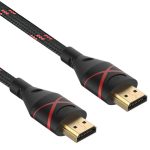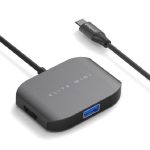HDMI, or High-Definition Multimedia Interface, has revolutionized the way we connect our devices and experience audio-visual content. With its capability to transmit high-quality video and audio signals, HDMI has become the go-to standard for connecting a variety of devices, including laptops, gaming consoles, Blu-ray players, and streaming devices, to TVs and monitors. How do I watch TV through HDMI?
Let’s dive into the world of HDMI connectivity and explore the step-by-step process of watching TV through HDMI, ensuring a seamless and enjoyable viewing experience.
Contents
- 1 The Essentials: Understanding HDMI and its Role
- 2 Connecting Your Device: A Step-by-Step Guide
- 3 Optimizing Your Viewing Experience: Display Settings
- 4 Enhancing Your Viewing Experience: Picture Perfect
- 5 Immersive Audio: Setting the Stage for Sound
- 6 Troubleshooting: Overcoming Common Hiccups
- 7 Conclusion
The Essentials: Understanding HDMI and its Role
How do I watch TV through HDMI? Before we delve into the connection process, it’s important to grasp the basics of HDMI and its function in transmitting video signals.
Digital Interface
HDMI is a digital interface that carries both high-definition video and audio signals between devices. It has replaced older analog connections like VGA or composite cables, offering superior picture and sound quality.
Single Cable Convenience
HDMI eliminates the need for multiple cables, streamlining your setup and reducing clutter. A single HDMI cable carries both video and audio signals, simplifying the connection process.
Widespread Compatibility
HDMI ports are ubiquitous in modern TVs, monitors, laptops, gaming consoles, and other devices, making it a versatile and widely adopted standard.
Connecting Your Device: A Step-by-Step Guide
Let’s break down the simple process of connecting your device to your TV using an HDMI cable.
-
Locate the HDMI Ports: Identify the HDMI ports on both your source device (e.g., laptop, gaming console) and your TV. These ports are usually rectangular in shape and labeled as “HDMI.”
-
Connect the HDMI Cable: Take an HDMI cable and plug one end into the HDMI output port on your source device and the other end into an available HDMI input port on your TV. Ensure both ends are securely plugged in.
-
Power On: Turn on both your source device and your TV.
-
Select the Correct Input: Use your TV remote or the buttons on the TV itself to navigate to the input settings and select the HDMI input that corresponds to the port where you connected the cable.
Troubleshooting Tips
-
No Signal: If your TV displays a “No Signal” message, double-check the cable connections and ensure you’ve selected the correct HDMI input source. Try power cycling both devices or using a different HDMI cable.
-
Image or Audio Issues: If you experience flickering, distorted images, or audio problems, try adjusting the resolution or refresh rate settings on your source device or the TV. Ensure your graphics and audio drivers are up to date.

Optimizing Your Viewing Experience: Display Settings
Once connected, you can fine-tune the display settings to optimize your viewing experience.
-
Resolution: Adjust the resolution of the output signal to match your TV’s native resolution for optimal picture quality. Most modern TVs support high-definition resolutions like 1080p or even 4K.
-
Aspect Ratio: The aspect ratio determines the shape of the image. Common options include 16:9 (widescreen) and 4:3 (standard). Choose the aspect ratio that matches your content or preference.
-
Overscan: Overscan can cause the image to be slightly zoomed in, potentially cropping out edges. Disable overscan if you want the full image to be displayed.
-
Picture Mode: Different picture modes (e.g., Standard, Cinema, Game) offer varying color and contrast settings. Experiment with different modes to find one that suits your content and viewing environment.
Accessing Display Settings
-
Source Device: You can typically adjust display settings on your laptop or other source device through its display or settings menu.
-
TV or Monitor: Access the display settings on your TV or monitor using its remote control or the on-screen menu.
Enhancing Your Viewing Experience: Picture Perfect
Now that you’ve successfully connected your devices, it’s time to ensure your TV delivers the best possible picture quality.
-
Adjusting Picture Settings: Most modern TVs offer a plethora of picture settings that can be adjusted to your preference.
-
Brightness and Contrast: Fine-tune the brightness and contrast settings to achieve a clear and balanced image with good detail in both dark and bright areas.
-
Sharpness: Adjust the sharpness setting to enhance details without introducing excessive noise or artifacts.
-
Color: Calibrate the color settings to ensure accurate and vibrant colors. Some TVs offer preset color modes like “Movie” or “Game” that optimize the picture for different content types.
-
Motion Smoothing: This feature, also known as motion interpolation, can create a smoother appearance for fast-moving content. However, it can also introduce a “soap opera effect” that some viewers find unnatural. Experiment with this setting to find your preference.
-
-
Aspect Ratio: Ensure the aspect ratio of the output signal from your device matches your TV’s native aspect ratio. This prevents stretching or distortion of the image. Common aspect ratios include 16:9 (widescreen) and 4:3 (standard).
-
Overscan: Overscan can cause the image to be slightly zoomed in, potentially cropping out edges. Disable overscan if you want the full image to be displayed.
- Calibration Discs or Apps: For professional-level calibration, consider using calibration discs or apps that guide you through the process of adjusting your TV’s settings for optimal picture quality.
 Immersive Audio: Setting the Stage for Sound
Immersive Audio: Setting the Stage for Sound
HDMI not only delivers stunning visuals but also transports high-quality audio. Let’s explore how to optimize your audio settings for an immersive sound experience.
-
Audio Output Format: Depending on your devices and preferences, you can choose from various audio output formats, such as stereo, 5.1 surround sound, or even Dolby Atmos. Select the format that your audio equipment supports and that best suits your content.
-
Audio Device Selection: If you have multiple audio output devices connected to your source device, such as headphones and external speakers, ensure you’ve selected the correct one for HDMI output. This can usually be done through your device’s sound settings.
-
Volume Levels: Double-check the volume levels on both your source device and the TV or audio receiver. Make sure they are not muted or set too low.
-
Audio Delay or Lip Sync Issues: If the audio is out of sync with the video, check your TV’s audio settings for an option to adjust audio delay or lip sync. You might also need to disable any audio processing features that could introduce delays.
Sound Enhancement
-
Soundbars and Surround Sound Systems: For a truly immersive audio experience, consider connecting a soundbar or a surround sound system to your TV via HDMI ARC or eARC.
-
Audio Settings Exploration: Explore the audio settings on your TV or audio receiver to fine-tune the sound and customize it to your preferences.
Troubleshooting: Overcoming Common Hiccups
How do I watch TV through HDMI? Even with a seemingly straightforward setup, HDMI connections can occasionally encounter hiccups. Let’s explore some common issues and their solutions.
-
No Signal: If your TV displays a “No Signal” message, double-check the cable connections and ensure you’ve selected the correct HDMI input source. Try power cycling both devices or using a different HDMI cable.
-
Image Issues: If you experience flickering, distorted images, or color problems, try adjusting the resolution or refresh rate settings on your source device or the TV. Ensure your graphics drivers are up to date.
-
Audio Issues: If you’re not getting any sound through the HDMI connection, check your audio output settings and ensure HDMI is selected. If you’re using external speakers or a soundbar, verify their connections and settings.

Conclusion
How do I watch TV through HDMI? Watching TV through HDMI offers a seamless and high-quality viewing experience, allowing you to enjoy your favorite content on a larger screen with enhanced audio. By following these simple steps, troubleshooting common issues, and optimizing your display and audio settings, you can create a captivating and immersive home entertainment setup.
Remember, HDMI is a versatile and widely adopted standard. So, whether you’re connecting your laptop, gaming console, or streaming device, embrace the power of HDMI and elevate your viewing pleasure to new heights.


